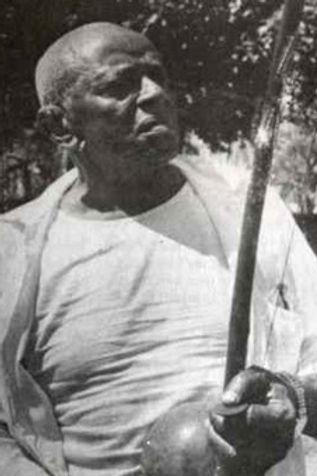MESTRE BIMBA
Founder of Capoeira Regional
Manuel dos Reis Machado, known as “Mestre Bimba” was born November 23rd, 1899, at the “bairro do Engenho Velho” in Salvador-BA, Brazil.
Mestre Bimba began Capoeira at the age of 12 at Estrada das Boiadas, today known as ” bairro da Liberdade,” in Salvador and was taught by “Bentinho”, an African who was the captain of a shipping company called the Companhia de Navegação Bahiana.
Capoeira was officially prohibited during and even after slavery. Nevertheless, it was practiced by the poorer population on public holidays, during work-free hours and similar occasions In spite of the official ban, Mestre Bimba created a new style. He incorporated new moves and techniques. He became extremely proficient in “Batuque” a type of fighting brought by Africans during their enslavement in Brazil, which he learned from his father. He later mastered Capoeira Angola, combining these two art forms to produce an exclusive Bahian Capoeira called Capoeira Regional or “Luta Regional Baiana” was then a more martial art oriented, effective, efficient and athletic style of Capoeira. The central component to teaching Capoeira Regional is the “Sequencia,” a learning process that was non-existent in Capoeira until it’s introduction by Mestre Bimba.
A performance at the palace of Bahia’s Governor, Juracy Magalhães, was the stepping stone needed for Mestre Bimba to finally convince the authorities of the cultural value of Capoeira, thus ending its official ban in the 1930’s and opening doors for Mestre Bimba.Mestre Bimba founded the first Capoeira school in 1932, the “Academia-escola de Capoeira Regional”, in Salvador-Bahia. As Capoeira was still heavily discriminated by upper class Brazilian society Bimba attempted to change the slyness and malicious reputation associated with Capoeira practitioners by setting new standards to the art. His students had to wear a clean, white uniform, show proof of grade proficiency from school, show good posture and many other standards. As a result, doctors, lawyers, politicians, upper middle class people, and women (until then excluded) started to join his school. The main characteristics of Mestre Bimba’s Capoeira were: The training of the art in enclosed school facilities; the implementation of a course curriculum; the introduction of a systematic training method; a defined musical ensemble of one berimbau and two pandeiros, and an emphasis placed on the rhythms of São Bento Grande, Benguela and Iuna, which mandated specific jogos.
For these reasons Mestre Bimba was and still is so important to Capoeira because he changed its destiny. In 1942, Mestre Bimba opened his second school at the “Terreiro de Jesus – rua das Laranjeiras”; today rua Francisco Muniz Barreto, #1. He also taught Capoeira to the army and at the police academy. He was considered “the father of modern Capoeira”. Mestre Bimba was a coalman, carpenter, warehouse man, longshoreman, horse coach conductor, but mainly capoeirista; a giant with strong personality! In 1973, Bimba was unhappy with a number of false promises and a lack of support from local authorities in Bahia. By invitation from an ex-student, he moved to Goiânia-GO in order to continue teaching Capoeira Regional, but unfortunately only a year later, on February 15th, 1974 Bimba died due to a stroke.
Four years later, at the request of his former students, his body was brought back to Salvador, where he lies in a tomb built especially for him in a public square.
From “Bimba: Perfil do Mestre” (1982) by Raimundo Cesar Alves de Almeida, (Mestre Itapoan).
